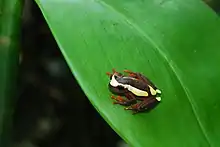Dendropsophinae
Dendropsophinae is a subfamily of small neotropical tree frogs in the family Hylidae. They are distributed from southern Mexico, throughout Central America, and down South America (including Trinidad) to northern Argentina and Uruguay.[1] Removed from the synonymy of Hylinae in 2016,[1][2] this taxon is not recognized in all recent reference works.[3]
| Dendropsophinae | |
|---|---|
 | |
| Dendropsophus bifurcus | |
| Scientific classification | |
| Kingdom: | Animalia |
| Phylum: | Chordata |
| Class: | Amphibia |
| Order: | Anura |
| Family: | Hylidae |
| Subfamily: | Dendropsophinae Fitzinger, 1843 |
| Type genus | |
| Dendropsophus Fitzinger, 1843 | |
| Genera | |
|
2 genera (see text) | |
The family name comes from the Greek word dendron which means "tree" and psophos which means "sound" or "noise," referring to how you are more likely to hear the frogs singing up in the trees rather than actually seeing them. They first evolved around 25.3–38.5 million years ago, splitting from Pseudinae during the Eocene 39.1–50.8 Mya and diversifying during the early Oligocene 25.3–38.5 Mya.[2]
Genera
There are only two genera in the subfamily Dendropsophinae:[1][2]
- Dendropsophus Fitzinger, 1843
- Xenohyla Izecksohn, 1998
Xenohyla is confined to only coastal Brazil, while the range of Dendropsophus is much larger. Xenohyla has 2n=24 chromosomes while Dendropsophus has 2n=30 chromosomes.[2]
References
- Frost, Darrel R. (2020). "Dendropsophinae Fitzinger, 1843". Amphibian Species of the World: An Online Reference. Version 6.1. American Museum of Natural History. doi:10.5531/db.vz.0001. Retrieved 30 July 2020.
- Duellman, William E.; Marion, Angela B. & Hedges, S. Blair (2016). "Phylogenetics, classification, and biogeography of the treefrogs (Amphibia: Anura: Arboranae)". Zootaxa. 4104 (1): 1–109. doi:10.11646/zootaxa.4104.1.1. PMID 27394762.
- "Hylidae". AmphibiaWeb. University of California, Berkeley. 2020. Retrieved 30 July 2020.